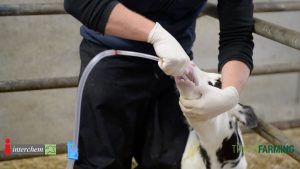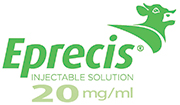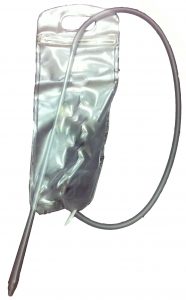Why stomach tube a calf?
The ability to stomach tube a calf is a necessity on any farm dealing with young calves. This process can be used to feed a new born calf colostrum, administer fluids that contain electrolytes or relieve bloated gas.
Weak calves may not be able to drink liquids from a teat. Stomach tubing is the best way of ensuring that they consume enough liquid. Some dairy farmers routinely stomach tube all new-born calves to provide adequate levels of colostrum (3 litres) and be certain that they will absorb sufficient antibodies to enhance their immunity against diseases. Scouring calves with severe dehydration, that are too weak to drink themselves, can also be stomach tubed.
The stomach tube is a flexible piece of plastic tubing with a bulbous-shaped end designed to be easily inserted into the oesophagus, but not into the lungs. It is usually attached to a plastic container holding the liquid feed. The most commonly available type is a plastic bag with a clip to stop/start the flow of liquid.
How to stomach tube a calf
 1. The first step in using the stomach tube is to determine the length of tube to be inserted. This is measured as the distance from the tip of the calf’s nose to the point of its elbow behind the front leg, usually 45 cm or more. This point can be marked on the tube with a piece of tape. Ideally, the calf should be standing so the fluids are less likely to back up and enter its lungs. However, calves that are too weak to stand, can be tubed in a sitting position and even while lying down. The stomach tube is easier to use when calves are restrained. Young calves can be backed into a corner for better head control.
1. The first step in using the stomach tube is to determine the length of tube to be inserted. This is measured as the distance from the tip of the calf’s nose to the point of its elbow behind the front leg, usually 45 cm or more. This point can be marked on the tube with a piece of tape. Ideally, the calf should be standing so the fluids are less likely to back up and enter its lungs. However, calves that are too weak to stand, can be tubed in a sitting position and even while lying down. The stomach tube is easier to use when calves are restrained. Young calves can be backed into a corner for better head control.
2. If the weather is cold, the tube can be placed in warm water to make it more pliable. The tube should be dipped into a lubricant, such as mineral or vegetable oil.
3. The tip of the tube is then placed into colostrum or whole milk, whichever is to be fed. Calves may suck the end of the tube, making it easier for it pass into the oesophagus.
4. Ensure the end of the pipe is not cracked or damaged as this will harm the calf.
5. A calf’s mouth can be opened by gently squeezing the corner of the mouth or by grabbing its head over the bridge of the nose and gently squeezing the upper palate or gums.
6. Once it is opened, the empty tube should be passed slowly along the tongue to the back of the mouth. When the tube is over the back of the tongue, the calf starts chewing and swallowing it, after which the tube is passed down into the oesophagus. The end of the tube can be felt quite easily. Never force the tube; if it is being correctly put down the oesphagus, it should slide in quite easily.
7. After the tube is in place and before any fluids are given, it should be checked for proper positioning in the oesophagus. If it is properly positioned, the rings of the trachea (leading into the lungs) and the rigid enlarged oesophagus can be felt easily. If you cannot feel both of these, remove the tube and start again. Remember the “2 tube rule” you should be able to feel the trachea and the stomach tube pipe!!
8. The tube can be unclipped or straightened out or the container can be tipped up to allow liquid to flow down into the stomach. Liquids should be at body temperature (38⁰C) to prevent shock to an already weak calf. It may take three minutes or more to allow sufficient fluid to be administered. The calf will regurgitate less with a slow flow rate.
9. When feeding is over, the tube should be slowly removed. The tube should be cleaned and sanitised, then allowed to drain and dry.
10. Use two tubes, one for tubing sick/scouring calves and one for giving colostrum to avoid disease transfer.
Click here to the PharVet site to source stomach tubes.
Follow our Being Brilliant at the Basics video series to learn more on www.procalf.com



